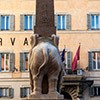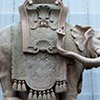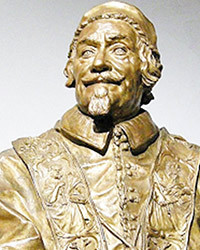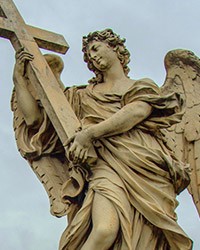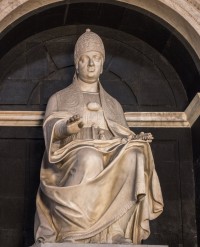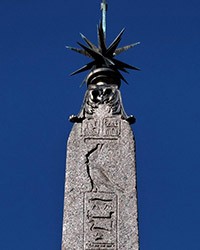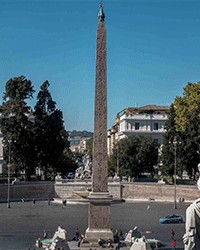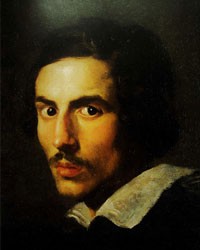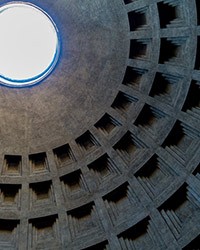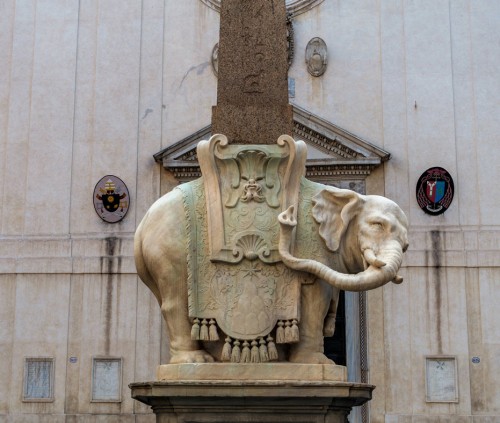
Minerva Obelisk according to the design of Gian Lorenzo Bernini
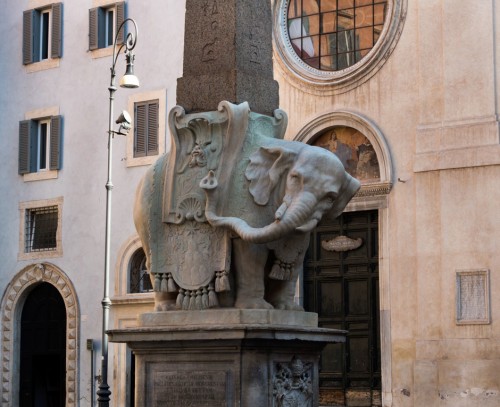
Minerva Obelisk in front of the Basilica of Santa Maria sopra Minerva, sculpture of the elephant by Ercole Ferrata

Minerva Obelisk dedicated to Pope Alexander VII
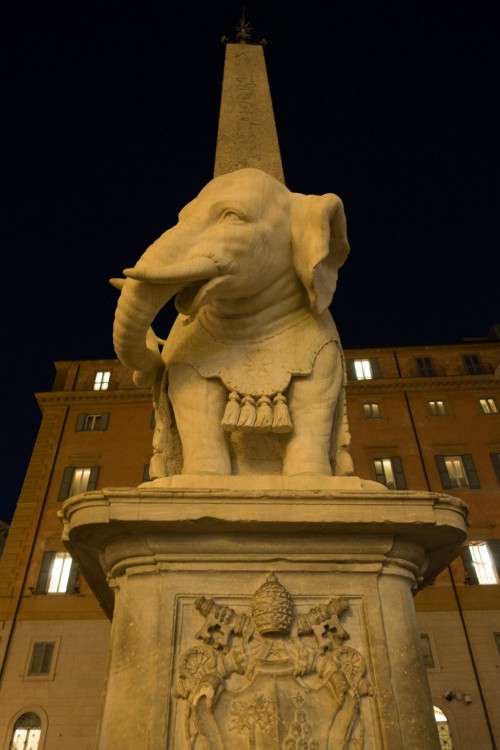
Minerveo Obelisk
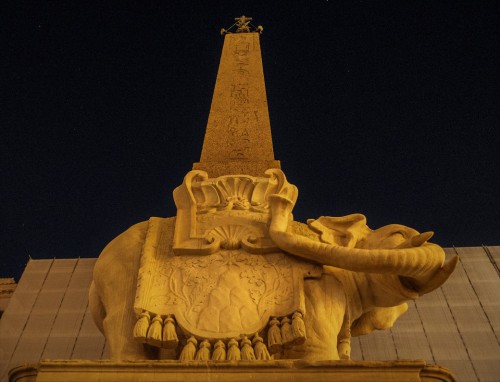
Minerva Obelisk on Piazza della Minerva
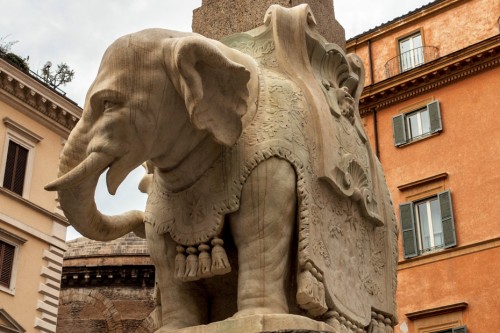
Obelisk Minerveo on Piazza della Minerva
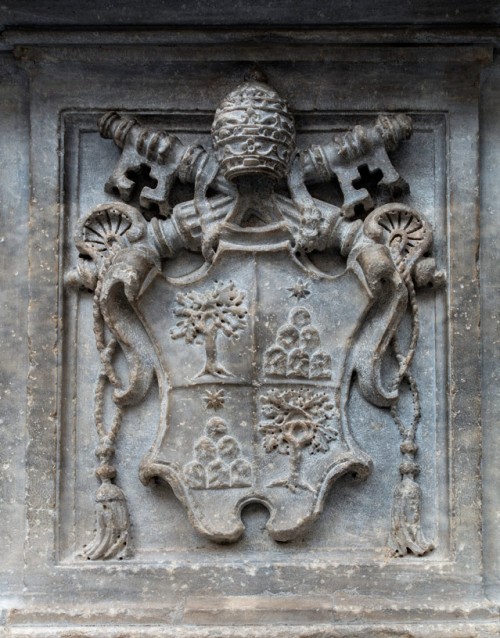
Obelisk Minerveo, coat of arms of Pope Alexander VII from the Chigi family
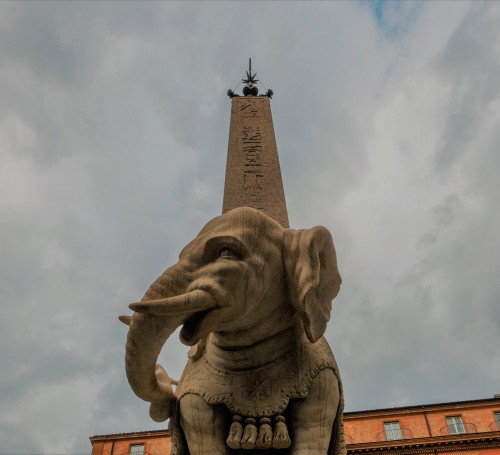
Minerveo Obelisk
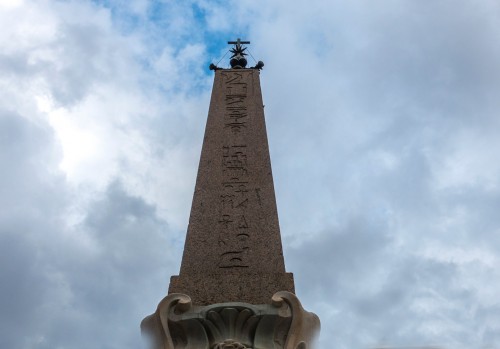
Minerveo Obelisk
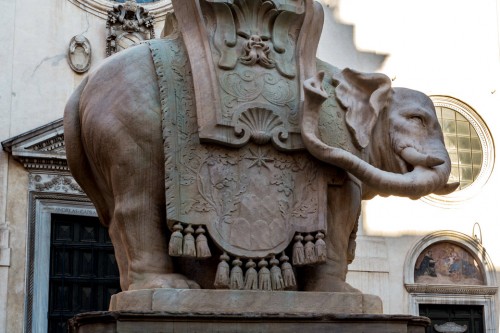
Minerveo Obelisk, star and six mountains – the symbols of the coat of arms of Pope Alexander VII

Minerva Obelisk in front of the covered façade of the Basilica Santa Maria sopra Minerva
Pope Alexander VII did not even attempt to hide his amazement, when in 1655 in the garden of the Santa Maria sopra Minerva monastery, a granite obelisk was discovered. It came from the ancient complex of the Temple of Isis. For the pope it was an inspiration, but also a problem – how to take advantage of it, where to place it?
Pope Alexander VII did not even attempt to hide his amazement, when in 1655 in the garden of the Santa Maria sopra Minerva monastery, a granite obelisk was discovered. It came from the ancient complex of the Temple of Isis. For the pope it was an inspiration, but also a problem – how to take advantage of it, where to place it?
The designs of the Dominicans, on whose property the discovery was made came to nothing. In their desire to appeal to the pope, they suggested enriching the obelisk with six mountains (an element of the pope’s coat of arms) and… the statues of four dogs. These animals were a reference to the Dominicans themselves, since the Middle Ages referred to as Domini canes (hounds of the Lord) – diligent trackers of insubordination when it came to the Church doctrine, sniffing out heretics and conducting inquisition trials.
We can imagine, the pope calling for the famous artist Gian Lorenzo Bernini, to ask him for advice, while he – perhaps – equally excited with the vision of the the Egyptian obelisk, let his imagination run wild. When he came back to the pope with the ready idea, the pontiff had to be surprised, but also to a large extent satisfied. An elephant? Why an elephant, an exotic animal and unknown in Rome? But is that really the case? Since ancient times they were regarded as a symbol of wisdom and this conviction could not have been weakened even by the Middle Ages. Emphasis was placed on the intelligence of these animals, their sexual restraint, gentleness and readiness to provide help, as well as longevity. It should come as no surprise that during the cinquecento and seicento period, they returned. One of them even lived at the beginning of the XVI century in the Eternal City. This was Hanno, a gift from the King of Portugal Emanuel I, for an enthusiast of parties and the joys of life – Pope Leo X. Unfortunately he did not enjoy a long life: similarly to his owner he suffered from stomach problems and died after a two-year stay in Rome from overeating. However, this was not the only inspiration for Bernini – the artist turned to a literary work, full of ancient culture, that was treated with distrust by the Church – the Hypnerotomachia Poliphli (Poliphilo’s Strife for Love in a Dream), which was published in 1499 and at the beginning of the following century became a true hit among the readers of the then elites. However, it was not so much the content of this book that inspired the sculptor, but more the woodcuts it contained, including the one depicting an elephant with an obelisk on his back. Combining the wisdom of Egyptian hieroglyphs with papal virtues seemed extremely interesting both to the designer as well as his client. When news of papal plans reached the Dominicans, they did not hide their criticism and ridiculed Bernini. Reportedly, this was the reason that when the obelisk ultimately stood in front of their church its rear end was directed by the artist towards the Dominican monastery.
The obelisk which was 5.5 meters high, was enriched by Bernini with an elephant and a high pedestal, thus reaching the height of 12.29 meters. However, sculpting the elephant was entrusted by the artist to one of his most skilled collaborators – Ercole Ferrata. Of course the pedestal had to contain inscriptions informing of the pope’s foundation, as well as his coat of arms (six mountains and an oak tree). There is a beautiful sentence concerning the pope himself:
Whoever sees here that the symbols of the Egyptian sage, inscribed
on the obelisk, are carried by the elephant, the strongest of the beasts:
understand that it is a proof of a robust mind
to sustain solid wisdom." (translation: Matylda Amat-Obryk)
Interestingly enough, the obelisk was discovered during the year of the election of Pope Alexander VII, while it was ready in front of the Basilica of Santa Maria sopra Minerva in the year of his death – 1667.














